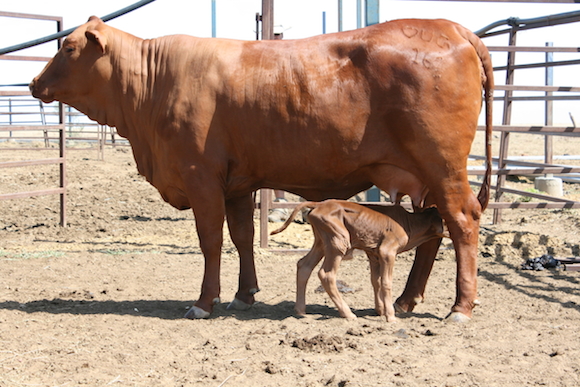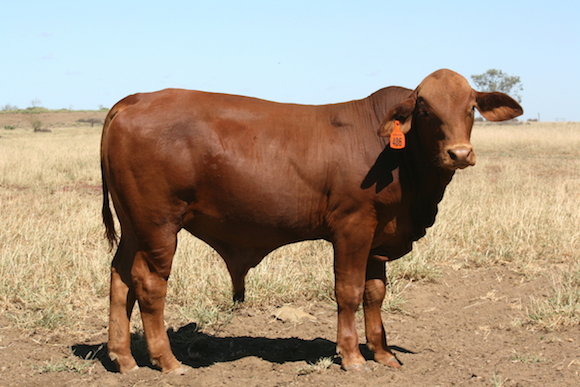The story of Goliath
Host: Eversleigh Station
Written by Jenny Underwood – Owner, Eversleigh Station.
Nothing gives me more pleasure than to see a new-born calf with its mother, especially if it a first-calf heifer (i.e. a first time mum). Her innate mothering skills kick in not long after the birth of the calf and she is rapidly transformed from a carefree “teenager” into a cow with responsibilities!
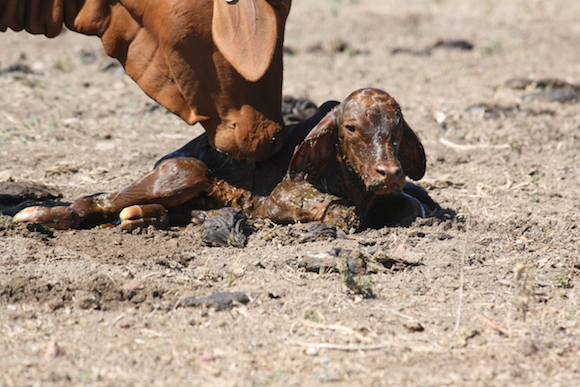 A newborn calf. Immediately after its delivery the mother starts to lick the calf and remove the birth sac. It is also important that the calf shake its head to remove fluid from its nose and mouth.
A newborn calf. Immediately after its delivery the mother starts to lick the calf and remove the birth sac. It is also important that the calf shake its head to remove fluid from its nose and mouth.
However, not all calvings are simple and straightforward and some heifers and even cows, like humans, can have difficulty and whenever possible we will help a cow deliver her calf.
A cow’s pregnancy lasts approximately 283 days – just over nine months. In March of 2012 we undertook our first-ever Artificial Insemination (AI) program. Because we knew exactly which day the heifer “fell pregnant” we could determine fairly accurately when she would calve. To be on the safe side, we brought the heifers home to a holding paddock near the yards which enabled us to check on them regularly, and if needed, walk the heifer to the yards if she needed monitoring or assistance.
The summer of 2012/2013 was a shocker – we had dreadful heatwaves and week after week of mid-high 40 degree temperatures. The heifers started to calve a couple of days before Christmas Day; that was all well and good if they calved early in the morning or late in the afternoon when it was (supposedly) cooler. Each heifer had an identification tag in its ear, so we knew which animal to check that would be getting nearer her time for calving which made things much easier for monitoring purposes.
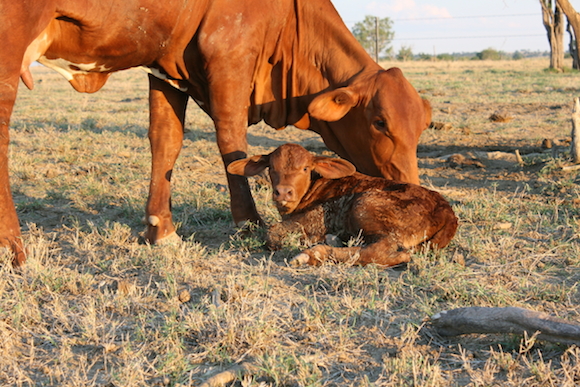 Christmas Day 2012. This little calf was one of three born that day. He was probably about 10 minutes old when I found him.
Christmas Day 2012. This little calf was one of three born that day. He was probably about 10 minutes old when I found him.
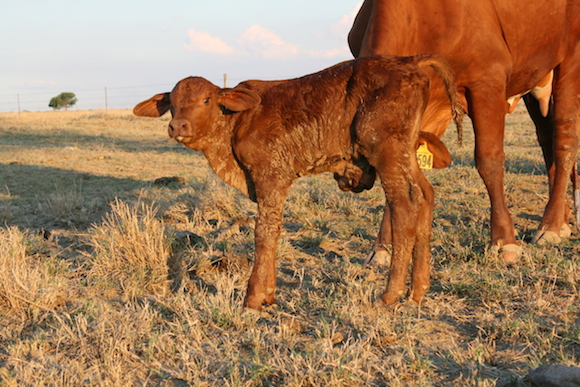 Within 20 minutes of being born the little fellow was already up on his feet. The mother continues to lick the calf until the majority of the birth sac is gone; she will also encourage the calf to have its first drink.
Within 20 minutes of being born the little fellow was already up on his feet. The mother continues to lick the calf until the majority of the birth sac is gone; she will also encourage the calf to have its first drink.
At the end of December we had to go to town for most of the day, so I rode the paddock before we left and found one heifer that had calved early that morning. Late that afternoon we checked on that heifer and she and her new calf were going great guns. For some unexplained reason, I decided we should check the rest of the paddock before it got dark. Often a cow will stand well away from the main mob when she is getting ready to have her calf. We noticed one heifer that wasn’t grazing contentedly like the rest of the heifers. When I saw her tag number I realised that she still had a couple of weeks to go before she was meant to calve. But there, at her feet, curled up into a tight ball was the tiniest little calf that we had ever seen. At first we though the calf might have been dead as it wasn’t moving and it was obviously premature.
We were surprised when it gave a muted little bellow but it was far too weak to stand by itself so we knew that it wouldn’t have had a drink at all. It was almost dark and it would have been futile to walk the heifer to the yards so we rushed home and mixed up a solution of electrolytes to feed the calf, a tiny bull. We hoped that the electrolytes would be enough to rehydrate it and that it would still be alive in the morning.
With trepidation we went back to the paddock very early the following morning. The heifer was still standing exactly where we’d left her and her tiny baby was still alive but very weak. I put the calf in the front of the ute with the airconditioning on and the heifer followed me to the yards – about one kilometre away – while Roger coaxed her along with the bike. Roger put the mother into the crush so that he could milk her out as her udder was very full and the calf needed to get the all-important first drink of colostrum if he was to have any chance of survival. We fed him using a bottle but as he was too weak to stand it wasn’t an easy task to ensure the milk went into the right stomach and it didn’t choke him.
We repeated this process three to four times per day and each time the heifer would patiently walk into the crush and be milked out; she was so quiet we didn’t even need to use a leg rope to prevent her from kicking out. The little calf could only drink a small amount of milk at a time. During the day it was unbearably hot and he was panting so much that at times he couldn’t drink at all. The little fellow was still very weak and unable to stand unassisted.
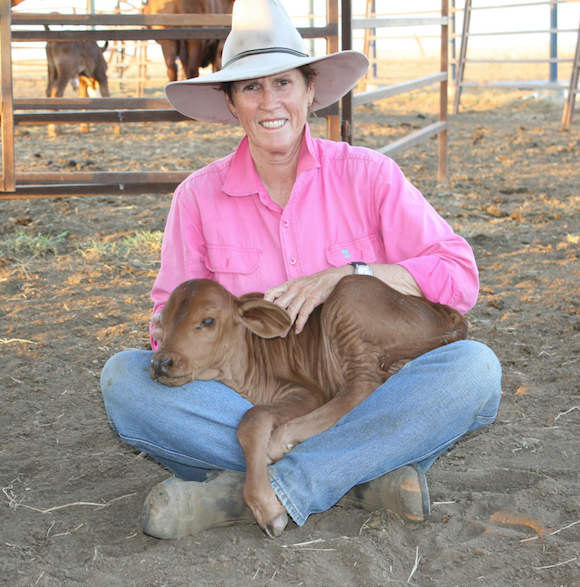 The little calf was so small that he could fit comfortably in my lap. Most newborn calves average about 35-40kg at birth – this calf weighed no more than 15kg.
The little calf was so small that he could fit comfortably in my lap. Most newborn calves average about 35-40kg at birth – this calf weighed no more than 15kg.
It would have been easy to give up and let the calf die but we were determined to give him the best chance at life that we could; his mother made it so much easier for us too allowing us to milk her with a minimum of fuss. I avoided taking many photos and we didn’t name him just in case the worst happened and he didn’t live.
Then, on the 3rd day a wonderful miracle happened. The little calf stood on his own; not for very long and it was a wobbly old effort, but he did stand! We brought him over to his Mum and encouraged him to suck. He was so tiny that he could only just reach up to the heifer’s teats. Fortunately she wasn’t an overly tall cow otherwise the little calf would never have been able to reach her udder on his own.
Success! The little calf could stand up unassisted and attempt to have a feed on his own. Full credit to the mother who recognised that it was her calf; she was very patient with him while he found his land legs.
We were overjoyed and so it was time to give the little man a name – because of the mighty effort he had put in and due to his “enormous” size he was christened Goliath. When Goliath was born he reminded us of one of those Shar Pei dogs – the ones with all the wrinkles and excess skin.
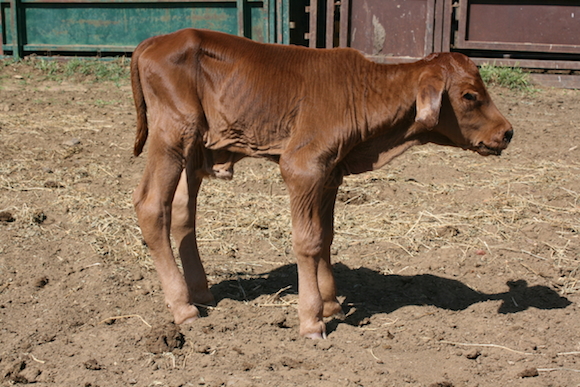 Three days old and standing alone! Goliath looked like a wrinkly old man. Even his ears still hadn’t filled out and they were all droopy like a new puppy’s.
Three days old and standing alone! Goliath looked like a wrinkly old man. Even his ears still hadn’t filled out and they were all droopy like a new puppy’s.
 The poor little fellow really felt the heat. This was at 9am and already the temperature was over 40 degrees making the air hot and dry. We rigged up a shade area for Goliath and he spent most of the day resting. His Mum would come and check on him regularly and give him a reassuring lick.
The poor little fellow really felt the heat. This was at 9am and already the temperature was over 40 degrees making the air hot and dry. We rigged up a shade area for Goliath and he spent most of the day resting. His Mum would come and check on him regularly and give him a reassuring lick.
The heatwave continued and we brought more heifers into the yards so that we could set up a shade shelter for them and their calves. Goliath now had some mates and once he became a little bit more confident on his wobbly legs he would try to play like they did once the sun had gone down and it was a bit cooler. Gradually Goliath began to fill out and wasn’t quite so wrinkly but he was still a lot tinier than the rest of the calves – even the newborns.
Goliath is one-week old. The other calf, born that afternoon, makes Goliath look like a dwarf. Even the heifer is curious about the funny little creature.
Goliath continued to thrive and he continued to amaze us with his determination to live. Full credit also has to go to his young mother, Eversleigh Ember. She was incredibly patient and the most attentive heifer imaginable. When the time came to let the heifers back out into the holding paddock to eat some green pick that had come up after a shower of rain little Goliath found it very hard to negotiate the rough ground.
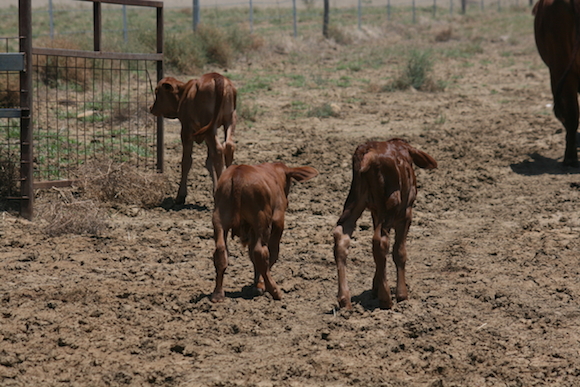 Goliath’s first big adventure. He is the oldest calf of these three.
Goliath’s first big adventure. He is the oldest calf of these three.
It was a big wide world out there and over three weeks since Goliath had been brought into the yards as a tiny little calf.

Once all the remaining heifers had finally calved out we took them back to their home paddock. Goliath had defied the odds and survived.
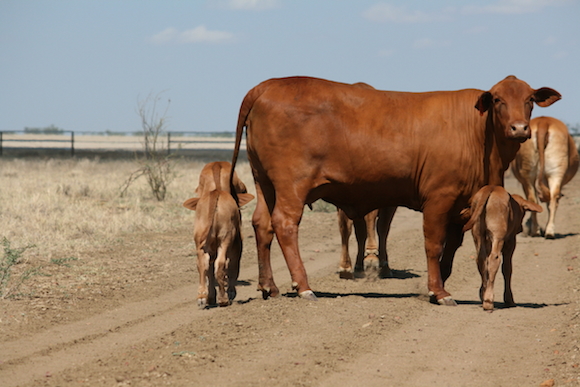
Goliath is still with us today – he is 16 months old, and, for now, we have kept him as a bull. He’s never going to be a tall animal but we figure that if his grit and determination can be passed onto his calves he deserves to “have a go” and live out his days on Eversleigh.

